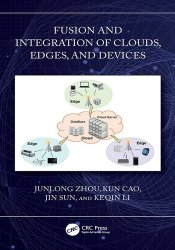Fusion and Integration of Clouds, Edges, and Devices
- Добавил: literator
- Дата: 27-10-2024, 01:13
- Комментариев: 0
 Название: Fusion and Integration of Clouds, Edges, and Devices
Название: Fusion and Integration of Clouds, Edges, and DevicesАвтор: Junlong Zhou, Kun Cao, Jin Sun, Keqin Li
Издательство: CRC Press
Год: 2025
Страниц: 228
Язык: английский
Формат: pdf (true), epub
Размер: 31.8 MB
This book provides an in-depth examination of recent research advances in cloud-edge-end computing, covering theory, technologies, architectures, methods, applications, and future research directions. It aims to present state-of-the-art models and optimization methods for fusing and integrating clouds, edges, and devices.
Cloud-edge-end computing provides users with low-latency, high-reliability, and cost-effective services through the fusion and integration of clouds, edges, and devices. As a result, it is now widely used in various application scenarios. The book introduces the background and fundamental concepts of clouds, edges, and devices, and details the evolution, concepts, enabling technologies, architectures, and implementations of cloud-edge-end computing. It also examines different types of cloud-edge-end orchestrated systems and applications and discusses advanced performance modeling approaches, as well as the latest research on offloading and scheduling policies. It also covers resource management methods for optimizing application performance on cloud-edge-end orchestrated systems.
The intended readers of this book are researchers, undergraduate and graduate students, and engineers interested in cloud computing, edge computing, and the Internet of Things (IoT). The knowledge of this book will enrich our readers to be at the forefront of cloud-edge-end computing.
Chapter 1 introduces the supporting technologies of cloud-edge-end orchestration, including cloud computing, edge computing, and IoT. For each supporting technology, we first present its basic concepts for better understanding. Regarding cloud computing, we also discuss its architectures, service quality metrics, and types. Edge intelligence has emerged as a prominent research topic that integrates edge computing and Artificial Intelligence (AI). We also study four key research dimensions of edge intelligence: edge offloading, edge caching, edge inference, and edge training. Concerning IoT, we mainly focus on the computing hardware and performance metrics of end devices.
Chapter 2 introduces the evolution of cloud-edge-end computing. It then presents the fundamental concepts, enabling technologies, and hierarchical/horizontal models of cloud-edge-end computing. The chapter finally concludes by discussing the research efforts of cloud-edge-end computing, including service and server placement methods, data analysis and training approaches, and resource management strategies.
Chapter 3 studies the performance models and optimization methods for cloud-edge-end orchestrated systems. The chapter begins with a discussion of the challenges faced in optimizing various aspects of cloud-edge-end orchestrated systems such as latency, energy consumption, security and privacy, and reliability. It then examines the various performance models associated with these systems and how they impact the overall performance. This includes models related to latency, energy consumption, security and privacy, and reliability.
Chapter 4 discusses the design and implementation of cloud-edge-end orchestrated applications in various domains such as IoT, cyber-physical systems (CPS), and smart cities. The IoT scenarios that are covered in this chapter include Intelligent IoT, time-sensitive IoT, and Internet of Vehicles.
Chapter 5 provides a summary of the book and suggests potential avenues for future research.
Contents:
Скачать Fusion and Integration of Clouds, Edges, and Devices
Внимание
Уважаемый посетитель, Вы зашли на сайт как незарегистрированный пользователь.
Мы рекомендуем Вам зарегистрироваться либо войти на сайт под своим именем.
Уважаемый посетитель, Вы зашли на сайт как незарегистрированный пользователь.
Мы рекомендуем Вам зарегистрироваться либо войти на сайт под своим именем.
Информация
Посетители, находящиеся в группе Гости, не могут оставлять комментарии к данной публикации.
Посетители, находящиеся в группе Гости, не могут оставлять комментарии к данной публикации.

